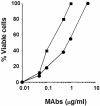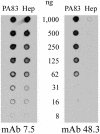Functional analysis of Bacillus anthracis protective antigen by using neutralizing monoclonal antibodies
- PMID: 15501759
- PMCID: PMC523002
- DOI: 10.1128/IAI.72.11.6313-6317.2004
Functional analysis of Bacillus anthracis protective antigen by using neutralizing monoclonal antibodies
Abstract
Protective antigen (PA) is central to the action of the lethal and edema toxins produced by Bacillus anthracis. It is the common cell-binding component, mediating the translocation of the enzymatic moieties (lethal factor [LF] and edema factor) into the cytoplasm of the host cell. Monoclonal antibodies (MAbs) against PA, able to neutralize the activities of the toxins in vitro and in vivo, were screened. Two such MAbs, named 7.5 and 48.3, were purified and further characterized. MAb 7.5 binds to domain 4 of PA and prevents the binding of PA to its cell receptor. MAb 48.3 binds to domain 2 and blocks the cleavage of PA into PA63, a step necessary for the subsequent interaction with the enzymatic moieties. The epitope recognized by this antibody is in a region involved in the oligomerization of PA63; thus, MAb 48.3 does not recognize the oligomer form. MAbs 7.5 and 48.3 neutralize the activities of anthrax toxins produced by B. anthracis in mice. Also, there is an additive effect between the two MAbs against PA and a MAb against LF, in protecting mice against a lethal challenge by the Sterne strain. This work contributes to the functional analysis of PA and offers immunotherapeutic perspectives for the treatment of anthrax disease.
Figures





References
-
- Bradley, K. A., J. Mogridge, M. Mourez, R. J. Collier, and J. A. Young. 2001. Identification of the cellular receptor for anthrax toxin. Nature 414:225-229. - PubMed
Publication types
MeSH terms
Substances
LinkOut - more resources
Full Text Sources
Other Literature Sources
Medical

